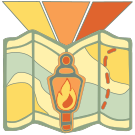Trail: Learn About Adaptation
Overview
| Trail: Learn About Adaptation | |
| Trail: Learn About Adaptation | |
|---|---|
| Landmarks | Impermanence Basic Understanding Experimenting with Cravings Learn About Non-Aversion |
What are Trails?
A Trail in the context of Everyday Enlightenment is a curated journey of self-discovery and personal growth. It is a structured way of traveling through concepts and practices and is designed to guide you towards mindfulness and deeper understanding. Using a Trail helps you systematically navigate and explore the vast landscape of meditative insights, providing you with achievable goals and practical techniques to integrate these insights into your everyday life.
What is Adaptation?
Adaptation, as a Beacon of Everyday Enlightenment, pertains to the acceptance and welcoming of life's impermanence. Adaptation focuses on key concepts like Impermanence, Non-Attachment, Non-Seeking and Non-Aversion, all revolving around our ability to flow harmoniously with life's constant shifts and changes.
The practice begins with understanding Impermanence, appreciating the transient nature of all phenomena, and gradually cultivating Non-Attachment to the desire for permanence in a world that's fundamentally transient. This naturally leads to Non-Seeking and Non-Aversion, attitudes that enable us to face life's fluctuations without craving desirable experiences or averting less pleasant ones.
Deeper exploration introduces us to concepts like Acceptance, Flexibility, and Resilience. These principles invite us to be comfortable amidst ambiguity, navigate life's changes smoothly, recognize the continuous movement in our experiences, acknowledge the ever-present evolution of all phenomena, and accept drastic changes as part of life.
Where will this Trail take you?
This trail is designed to take you to a place where you have a basic understanding of the Beacon of Adaptation, including the Lenses of Impermanence, Non-Attachment, Non-Seeking, Non-Aversion and Equanimity, as well as the Credo of Embrace the Change. Once you've completed this trail, it is recommended you read through the content on the Adaptation page.
Landmark 1 - Impermanence Basic Understanding
At this Landmark, you will get a chance to see the difference between seeing something as solid, steady, permanent as opposed to transient, ephemeral, impermanent. This is the first step in becoming a Learner in the Beacon of Adaptation.
 | |
| Landmark: Impermanence Basic Understanding | |
|---|---|
| Beacons | Adaptation |
| Realms | Enrollment |
| Lenses | Impermanence |
| Guides | Eating |
| Trails | Learn About Adaptation |
The Landmark of Impermanence Basic Understanding asks whether you are aware of the impermanence of all things at all times, that they are changing, decaying, and will not last. This Landmark is within the Realm of Enrollment, and is part of the Beacon of Adaptation, more specifically the Lens of Impermanence.
Landmark Lookouts:
- Notice Things Appear Solid: Are you able to notice how much we rely on the idea that things are solid and reliable?
- Think About How Things Won't Last: Can you feel a shift in perception as you think about something's impermanence, and how everything is going to change and decay over time?
A ready example of Impermanence can be found when you are drinking water.
- Next time you reach for your trusty water bottle, pause before you take a sip. We're going to try something.
- Hold the bottle in your hands. Really feel its weight, texture, temperature. Notice its shape, its color, its solidity.
- Seems permanent, right? It's a bottle, it's there, and it's real.
- Now, give it a little shake. Hear the water sloshing around inside? That's change right there. The water is moving, it's active. It's never the same from one moment to the next.
- Now take a sip. Feel the water going down your throat, refreshing and cool. The level of the water in the bottle has changed. The weight is different. Even the temperature might have changed slightly with your hand wrapped around it.
- So, even though it's still a bottle, it's not exactly the same bottle as it was a moment ago, is it?
- Continue with your work, but every time you reach for a sip, take a moment to notice these changes. The bottle gets lighter with each sip. The condensation on the outside might evaporate. The temperature shifts.
- Now take it a step further. Think about the water you're drinking. From your mouth, it goes into your system, hydrating you, becoming a part of you. So, in a way, the water’s journey continues, changing and flowing, just like everything else in this world.
- Through this everyday act, remind yourself: it's all in constant flux, even the seemingly solid and unchanging.
 | |
| Landmark: Impermanence Basic Understanding | |
|---|---|
| Beacons | Adaptation |
| Realms | Enrollment |
| Lenses | Impermanence |
| Guides | Eating |
| Trails | Learn About Adaptation |
The Landmark of Impermanence Basic Understanding asks whether you are aware of the impermanence of all things at all times, that they are changing, decaying, and will not last. This Landmark is within the Realm of Enrollment, and is part of the Beacon of Adaptation, more specifically the Lens of Impermanence.
Landmark Lookouts:
- Notice Things Appear Solid: Are you able to notice how much we rely on the idea that things are solid and reliable?
- Think About How Things Won't Last: Can you feel a shift in perception as you think about something's impermanence, and how everything is going to change and decay over time?
A ready example of Impermanence can be found when you are drinking water.
- Next time you reach for your trusty water bottle, pause before you take a sip. We're going to try something.
- Hold the bottle in your hands. Really feel its weight, texture, temperature. Notice its shape, its color, its solidity.
- Seems permanent, right? It's a bottle, it's there, and it's real.
- Now, give it a little shake. Hear the water sloshing around inside? That's change right there. The water is moving, it's active. It's never the same from one moment to the next.
- Now take a sip. Feel the water going down your throat, refreshing and cool. The level of the water in the bottle has changed. The weight is different. Even the temperature might have changed slightly with your hand wrapped around it.
- So, even though it's still a bottle, it's not exactly the same bottle as it was a moment ago, is it?
- Continue with your work, but every time you reach for a sip, take a moment to notice these changes. The bottle gets lighter with each sip. The condensation on the outside might evaporate. The temperature shifts.
- Now take it a step further. Think about the water you're drinking. From your mouth, it goes into your system, hydrating you, becoming a part of you. So, in a way, the water’s journey continues, changing and flowing, just like everything else in this world.
- Through this everyday act, remind yourself: it's all in constant flux, even the seemingly solid and unchanging.
Waypoint 2 - Learn About Non-Seeking
At this Waypoint, you'll experiment with cravings and how they affect your thoughts and emotions. Recognizing Craving is one aspect of preparing to understand Non-Seeking.
Lookouts
- Discovering Craving: Get ready to study your craving and understand what it's like and what it's made of.
- Being Pulled vs Thinking: Try to notice the difference between your craving (being pulled) and the mental thoughts that run through your head ("That chocolate looks so good").
 | |
| Landmark: Experimenting with Cravings | |
|---|---|
| Beacons | Adaptation |
| Realms | Enrollment |
| Lenses | Non-Seeking |
| Guides | Eating |
| Trails | Learn About Adaptation |
The Landmark of Experimenting with Cravings tests your experiences with cravings and how they affect your thoughts and emotions. This Landmark is within the Realm of Enrollment, and is part of the Beacon of Adaptation, more specifically the Lens of Non-Seeking.
Landmark Lookouts:
- Discovering Craving: Do you notice that there is a true craving to experience, that there's a strong feeling in your mind that you can "observe" in some way?
- Being Pulled vs Thinking: Can you distinguish between your craving (being pulled) and the mental thoughts that run through your head ("That chocolate looks so good")?
What better way to experiment with cravings than to take it literally, with some sort of sweet dessert...
- Select a snack or drink that you find particularly appealing. Make sure it's something you genuinely enjoy and look forward to having.
- Before you dive right in, take a moment to really look at your chosen treat. Notice its colors, its shape, its texture.
- Close your eyes and inhale. Can you smell the food or drink? What does it remind you of? Or maybe if it doesn't have a smell, test its weight or texture.
- Acknowledge the sense of anticipation building within you. You're eager to dig in, but don't just yet.
- Instead, explore that feeling of craving. It's like a tug in your gut, a mental image that won't go away, an expectation of pleasure.
- Take as much time as you need to really identify that there is a very real thought like "You should eat this now, go ahead and get started" and an emotion associated with that thought.
- Now, slowly start to eat or drink. Really focus on the experience - the texture, the taste, how it feels as you swallow.
- Take your time. With every bite or sip, observe how the intensity of your craving diminishes. What's replacing it? Satisfaction? A sense of calm?
- Reflect on this change. You went from craving to contentment, from anticipation to experience. And it all happened in a few moments.
- Carry this experience into your daily life. Whenever you find yourself desiring something, remember the snack. Recall how the craving came and went, and how the actual experience was just a series of moments, each passing away to make room for the next.Warning: Display title "<span class="PageType PageTypeLandmark">Landmark:</span> Experimenting with Cravings" overrides earlier display title "<span class="PageType PageTypeLandmark">Landmark:</span> Impermanence Basic Understanding".
Checkpoints
- Discovering Craving: Did you get a chance to really notice that there is a true craving to experience?
- Being Pulled vs Thinking: Were you able to distinguish between the Pulling and the Thoughts?
Waypoint 3 - Learn About Non-Aversion
At this waypoint, you will practice both experiencing and being patient with aversive sensations.
Lookouts
- Feeling the Aversion: It's important to take time and really observe what Aversion feels like.
- Being Patient: It doesn't matter how long you're patient for, what's important is practicing, and noticing what it feels like to be patient.
Checkpoints
- Feeling the Aversion: Did you get a chance to observe what it's like to really want something to be over, and how your mental state changes the longer you sit with that?
- Being Patient: Were you able to feel the mental state of being patient, and resting with an aversive sensation?
Destination
Congratulations, if you've completed these three Skills, and reviewed the Checkpoints, you are one Trail further along in your practice. Now that you have a basic idea of the concept, it's recommended you read through the article about the Beacon of Adaptation, and see if it starts to click with you. Then, look for other Trails and Skills that are in the Learning Milestone that can assist you further.
Resources
To learn more about these concepts, see the following articles. Template:Resources Impermanence Seeking
Warning: Display title "<span class="PageType PageTypeTrail">Trail:</span> Learn About Adaptation" overrides earlier display title "<span class="PageType PageTypeLandmark">Landmark:</span> Experimenting with Cravings".
